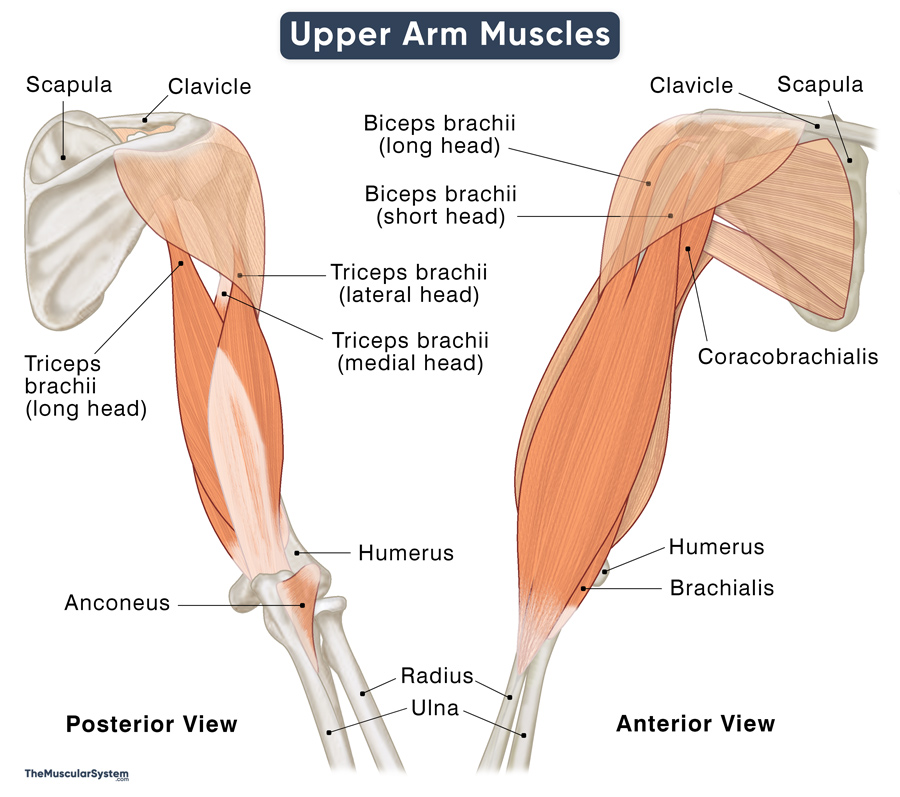Arm Muscles
The word ‘arm’ often refers to the upper extremities in humans. Still, anatomically, ‘arm’ refers to the ‘upper’ arm region between the shoulder and the elbow joint. The part below the elbow joint is referred to as the ‘lower’ arm or forearm. So, the 5 muscles in the upper arm are counted as the arm muscles.
Names & Anatomy of the ‘Upper’ Arm Muscles
The upper arm is divided into two compartments, the anterior (the front and inner side) and the posterior (the back and outer side). The group of 5 arm muscles is organized in these two compartments based on their actions.
Anterior Compartment
- Biceps brachii: It is a large two-headed superficial (on the side of the skin surface) muscle that connects the shoulder blade or scapula to the lower arm bone radius. It primarily helps to flex and abduct your arm at the elbow, mainly when the forearm is supinated (palm-up).
- Brachialis: A deep muscle beneath the biceps brachii, the brachialis connects the upper arm bone humerus to the ulna, one of the two forearm bones. It acts to help flex your forearm.
- Coracobrachialis: A slender muscle, also lying deep to the biceps. It connects the scapula to the humerus, making the muscle a strong adductor of the shoulder joint.
Posterior Compartment
- Triceps brachii: It is a three-headed superficial muscle connecting the scapula to the humerus at the back of the arm. It is the primary muscle involved in the extension of the elbow joint.
- Anconeus: Yet another superficial muscle at the back of the arm, this small muscle helps extend the elbow and rotate the forearm at the elbow.
What Do the Muscles in the Upper Arm Do
As is clear from the basic functioning of the above 5 muscles, the upper arm muscles are mainly involved in controlling elbow movements. There are 4 primary types of movements where the arm muscles are involved:
- Flexion: Bending at a joint, like folding your elbow.
- Extension: Straightening of a joint, like extending your elbow.
- Abduction: Moving a limb away from the body, like raising your arms to the sides.
- Adduction: Moving a limb opposite to abduction, like bringing your outstretched arm back towards the torso.
Names of the ‘Lower’ Arm Muscles
Even though anatomically referring to only the upper arm, as mentioned above, the word ‘arm’ refers to the whole upper extremity up to the hand in humans. So, here are the names of the rest of the muscles in the ‘arm’, also grouped as the ‘lower’ arm or forearm muscles:
Anterior Compartment
Superficial Anterior Forearm Muscles
- Pronator teres
- Flexor carpi radialis
- Palmaris longus
- Flexor carpi ulnaris
- Flexor digitorum superficialis
Deep Anterior Forearm Muscles
Posterior Compartment
Superficial Posterior Forearm Muscles
- Extensor digitorum
- Extensor digiti minimi
- Extensor carpi ulnaris
- Brachioradialis
- Extensor carpi radialis longus
- Extensor carpi radialis brevis
Deep Posterior Forearm Muscles
- Supinator
- Extensor indicis
- Abductor pollicis longus
- Extensor pollicis brevis
- Extensor pollicis longus
References
- Arm muscles: KenHub.com
- Arm Muscles Overview: HealthLine.com
- Arm muscles: GetBodySmart.com
- Arm Muscles: ClevelandClinic.org
- Muscles of the Arm and Hand: innerbody.com






